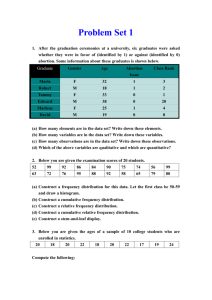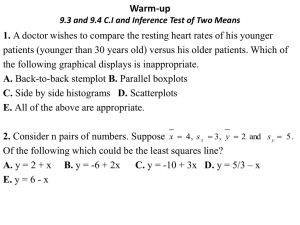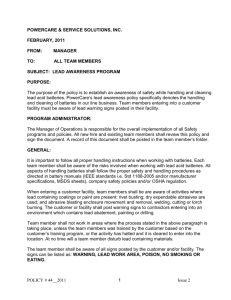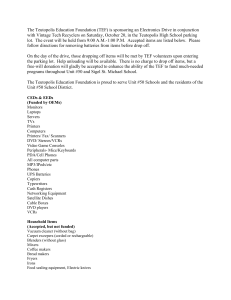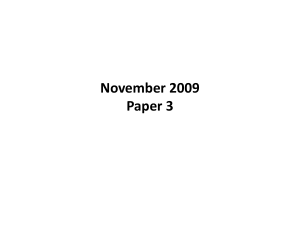Lithium-ion batteries-transportation
advertisement
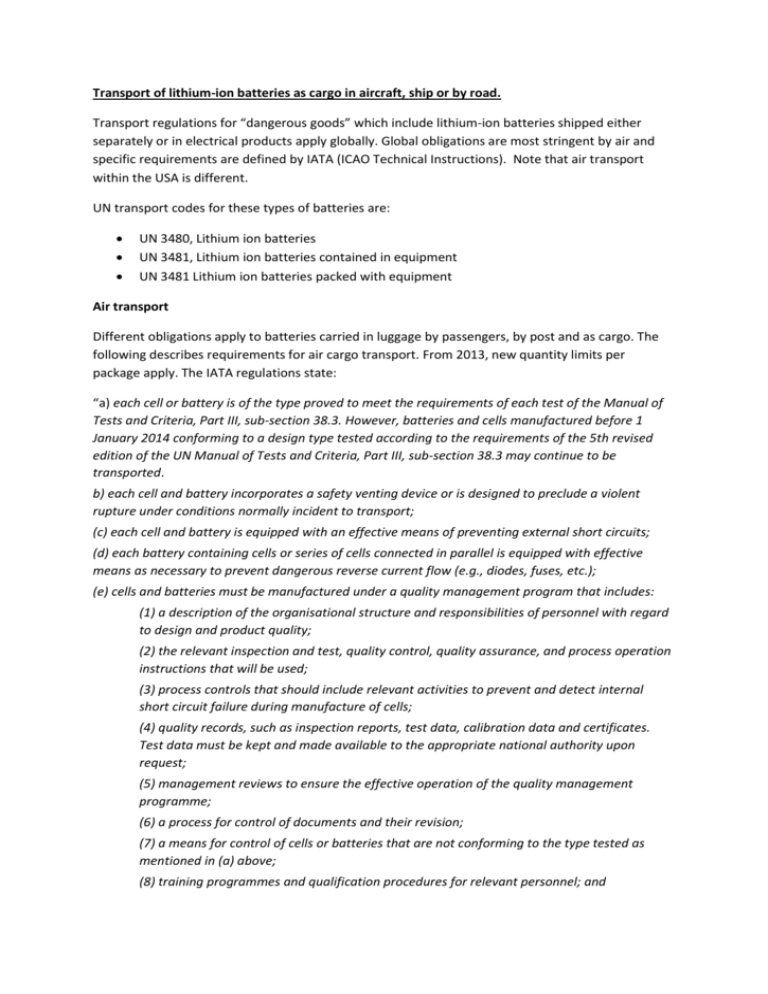
Transport of lithium-ion batteries as cargo in aircraft, ship or by road. Transport regulations for “dangerous goods” which include lithium-ion batteries shipped either separately or in electrical products apply globally. Global obligations are most stringent by air and specific requirements are defined by IATA (ICAO Technical Instructions). Note that air transport within the USA is different. UN transport codes for these types of batteries are: UN 3480, Lithium ion batteries UN 3481, Lithium ion batteries contained in equipment UN 3481 Lithium ion batteries packed with equipment Air transport Different obligations apply to batteries carried in luggage by passengers, by post and as cargo. The following describes requirements for air cargo transport. From 2013, new quantity limits per package apply. The IATA regulations state: “a) each cell or battery is of the type proved to meet the requirements of each test of the Manual of Tests and Criteria, Part III, sub-section 38.3. However, batteries and cells manufactured before 1 January 2014 conforming to a design type tested according to the requirements of the 5th revised edition of the UN Manual of Tests and Criteria, Part III, sub-section 38.3 may continue to be transported. b) each cell and battery incorporates a safety venting device or is designed to preclude a violent rupture under conditions normally incident to transport; (c) each cell and battery is equipped with an effective means of preventing external short circuits; (d) each battery containing cells or series of cells connected in parallel is equipped with effective means as necessary to prevent dangerous reverse current flow (e.g., diodes, fuses, etc.); (e) cells and batteries must be manufactured under a quality management program that includes: (1) a description of the organisational structure and responsibilities of personnel with regard to design and product quality; (2) the relevant inspection and test, quality control, quality assurance, and process operation instructions that will be used; (3) process controls that should include relevant activities to prevent and detect internal short circuit failure during manufacture of cells; (4) quality records, such as inspection reports, test data, calibration data and certificates. Test data must be kept and made available to the appropriate national authority upon request; (5) management reviews to ensure the effective operation of the quality management programme; (6) a process for control of documents and their revision; (7) a means for control of cells or batteries that are not conforming to the type tested as mentioned in (a) above; (8) training programmes and qualification procedures for relevant personnel; and (9) procedures to ensure that there is no damage to the final product. NOTE: In house quality management programmes may be accepted. Third party certification is not required, but the procedures listed in (1) to (9) above must be properly recorded and traceable. A copy of the quality management programme must be made available to the appropriate national authority upon request. Other obligations depend on the capacity in Wh of each lithium-ion (Li-ion) battery and the maximum net mass of each package. For the smallest size with capacity of <2.7Wh rating, there is no upper limit for the number of Li-ion batteries in one inner package but the maximum package weight is 2.5kg (reduced from 5kg). For Li-ion batteries with capacity of more than 2.7Wh but less than 20Wh, up to 8 cells are permitted in one package. The 35kg weight limit is unchanged. For Li-ion batteries with capacity of more than 20Wh and up to 100Wh, only two cells are permitted in one package. Batteries of >100Wh cannot be shipped by air. Lithium ion batteries shipped separately need to comply with special provisions A88. A99, A154, A164 and A183. Batteries in equipment need to comply with special provisions A48. A99, A154, A164, A181 and A185. A48. Packaging tests not needed A88, limited obligations for prototypes, not applicable here A99, batteries with mass >35kg so not applicable A154, shipping defective batteries A164, Prevention of short circuits or unintentional activation by insulating terminals A181 If package contains both separate batteries and equipment with batteries, mark with UN3081 A185. Applicable to battery powered vehicles There are complex and detailed packaging instructions PI 965 (separate batteries) and 967 in equipment in the IATA regulations. IATA Regulations state that all cells and batteries must be tested in accordance with the UN Manual of Tests and Criteria Part III Subsection 38.3. Other IATA requirements include: Employees responsible for shipping have had dangerous goods training from an approved trainer For these types of battery, packaging does not need to be UN approved type but must be sufficiently strong to prevent damage to the batteries in transit. Packaging must be labelled with the IATA “lithium battery handling” label, the correct UN number A means of preventing inadvertent activation of batteries is needed. Sea transport Shipping at sea is covered by the IMDG Regulations and for lithium batteries; the requirements are similar to those for air transport. The regulations include the same instructions as are included above from the IATA 54th edition that are summarised above. If they comply with these requirements then they may be shipped as long as they also comply with the following (extract from the IMDG regulation): Cells and batteries, except when installed in equipment, shall be packed in inner packagings that completely enclose the cell or battery. Cells and batteries shall be protected so as to prevent short circuits. This includes protection against contact with conductive materials within the same packaging that could lead to a short circuit. The inner packagings shall be packed in strong outer packagings which conform to the provisions of 4.1.1.1, 4.1.1.2, and 4.1.1.5. And for batteries shipped inside equipment: Cells and batteries when installed in equipment shall be protected from damage and short circuit, and the equipment shall be equipped with an effective means of preventing accidental activation. This requirement does not apply to devices which are intentionally active in transport (radio frequency identification (RFID) transmitters, watches, sensors, etc.) and which are not capable of generating a dangerous evolution of heat. When batteries are installed in equipment, the equipment shall be packed in strong outer packagings constructed of suitable material of adequate strength and design in relation to the packaging’s capacity and its intended use unless the battery is afforded equivalent protection by the equipment in which it is contained. Packages must be marked to indicate that they contain lithium-ion batteries; an indication that the package shall be handled with care and that a flammability hazard exists if the package is damaged; an indication that special procedures shall be followed in the event the package is damaged, to include inspection and repacking if necessary; and a telephone number for additional information. In practice, if the packaging and labels are suitable for air transport, they will also be suitable for shipping at sea, but some small differences may apply. Road transport This is covered by the ADR regulations. Lithium-ion batteries are classified as dangerous goods with specific obligations that are very similar to those required for air cargo transport described above. Lithium-ion batteries must fully comply with ADR (e.g. only use approved packaging, labels, etc.) unless they meet the detailed and quite lengthy requirements of special provision 188 (see chapter 3.3 of volume 1). Most of these obligations are however, the same as the IATA and IMDG requirements. The ADR volumes I and II are freely available via the Internet, unlike the IATA and IMDG Regulations which must be purchased and are updated annually. Transport Obligations for the USA These are different to the global obligations described above although exact requirements depend on the type of battery. The US classifies these batteries by lithium content with different obligations for each class. Batteries must pass UN T1-T8 tests and there are specific packaging requirements and labels. The UN tests are the same in the original sealed packaging with no more than three batteries per package as are required by IATA but the packaging and label requirements are not identical. The maximum amount of small lithium ion batteries that can be shipped by air is 2.5kg per outer package (either separate batteries or in equipment). Note that the US prohibits air transport (and by air mail) of primary lithium-metal batteries, but lithium-ion batteries may be transported by air as long as the requirements are met. Small lithium-ion batteries (max 8g lithium / cell) may be transported via road, rail and air in the USA. Cells or batteries must be separated and cushioned to prevent short circuit, movement or damage. The outside of the package must be marked on the address side, "Package Contains Lithium-ion Batteries (no lithium metal)." If equipment is shipped with small lithium-ion batteries that are properly installed in the device they operate, these must be protected from damage and short circuit, and the device must be equipped with an effective means of preventing accidental activation. The equipment must be cushioned to prevent movement or damage. Packages that contain batteries must also have the following label (some exceptions apply – this label; should also be used for transportation outside of the USA): Insert “ion” here to read LITHIUM ION BATTERY Be accompanied with a document indicating that packages contain lithium batteries and that special procedures should be followed in the event a package is damaged; Be capable of withstanding a 1.2 m drop test in any orientation without damage to the batteries in the package, without shifting that would allow short circuiting and without release of package contents The package must not exceed 30 kg gross weight. This limit does not apply to lithium cells or batteries packed with equipment. Packaging of equipment that contains lithium-ion batteries is more flexible but are classified as dangerous goods and must be labelled with UN3081. Sources of regulations and guidance. IATA – https://www.iata.org/publications/dgr/Pages/manuals.aspx DHL air transport guide http://www.dhl.co.uk/content/dam/downloads/g0/express/shipping/lithium_batteries/lithium_batt eries_interactive_tool.pdf Updates from http://www.icao.int/safety/DangerousGoods/Pages/technical-instructions.aspx State variations from http://www.icao.int/safety/DangerousGoods/Pages/StateVariationPage.aspx IMDG - Can be ordered via http://www.imo.org/Publications/IMDGCode/Pages/Default.aspx ADR – download free from http://www.unece.org/trans/danger/publi/adr/adr2013/13contentse.html USA legislation guidance – http://data.energizer.com/PDFs/LithiumIonBatteryTransport.pdf

